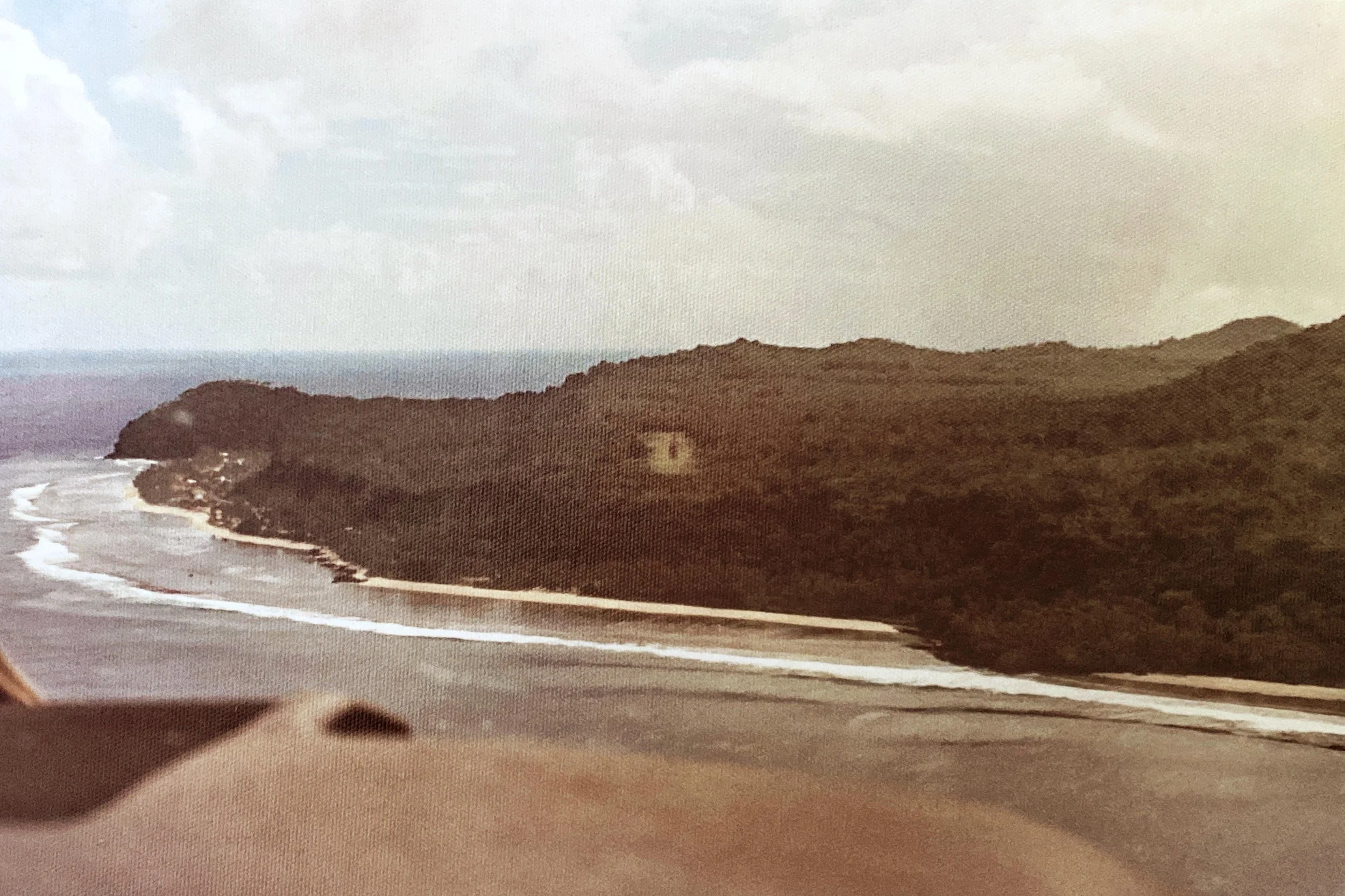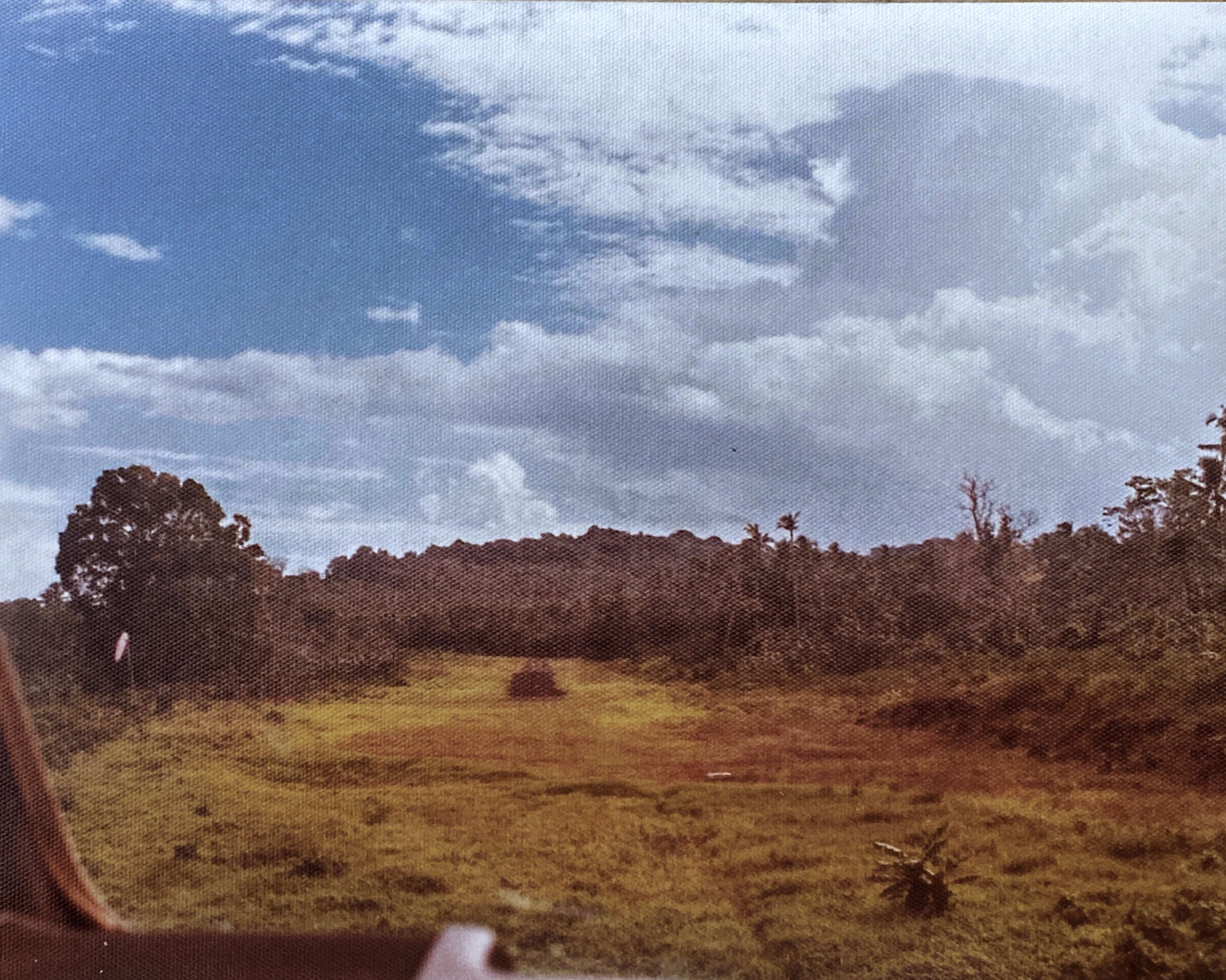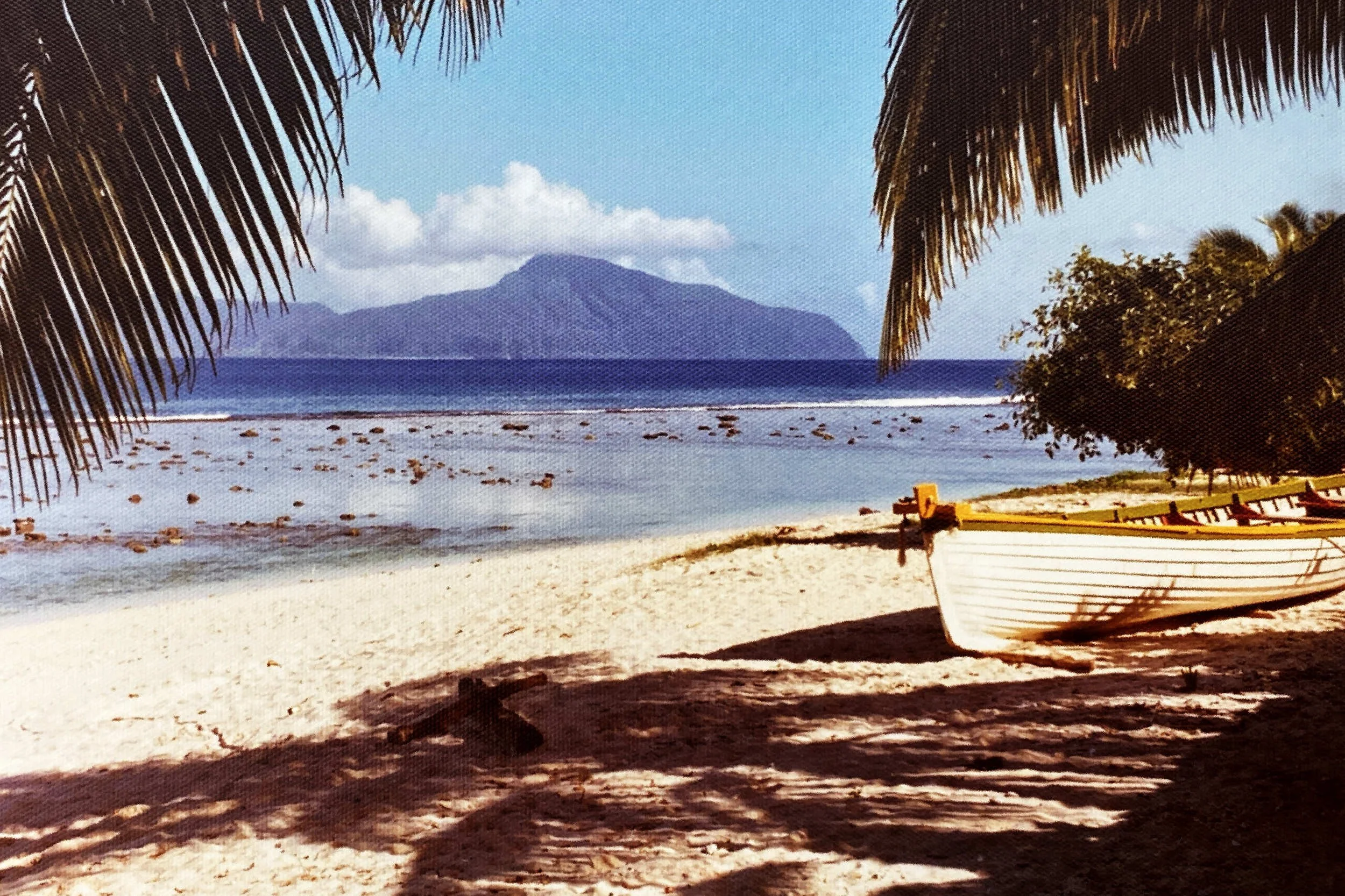A Few Additional Tales of the South Pacific—Part 3
It rained early on the morning of our second attempt to reach the island of Ta’u and we feared our flight would again be cancelled. But the rain over Tutuila slipped southward out to sea.
Jerry and I had packed light for our visit. We weren’t sure where—or whether—we were going to stay. We knew there were no hotels or restaurants of any kind, and we’d heard people with long hair and beards were not allowed on the island so, despite the mysterious note of unknown content from the Pago Chief of Police we were carrying, there was a good chance this was going to be a round-trip-flight rather than a visit (see Part 2 for details.)
South Pacific Island Airways operated a Britten-Norman Islander, a twin-prop high-wing plane configured (if memory serves) to carry cargo and to seat six, including the pilot. We already knew the pilot Dan since we were living and working at the airport.
Before takeoff, Dan reminded the passengers the flight wasn’t official until we got halfway to Ta’u and could see the island was clear of clouds—if it was shrouded in clouds or even if visibility was iffy, Dan would have to cancel the flight and turn back to Tutuila. He carried enough fuel to fly directly to Ta’u and back and if he wasted too much of it waiting for patches of mist to clear or whatever, after landing he’d have to find a lift back to Pago by fishing boat for more fuel, and transport it back to Ta’u the same way. At that time there was no regularly scheduled commercial boat service between Tutuila and Ta’u, just private fishing boats.
On this flight, there were five of us in the plane—Dan, Jerry, two Samoans, and me. With Dan’s ok I occupied the co-pilot seat out to Ta’u, and Jerry would occupy it back to Tutuila.
We leveled off at 5300 feet. The water below us was a brilliant blue-green, fading to a gray haze on the horizon where thin shields of altostratus were pierced by tall cumulus towers.
Halfway to Ta’u we caught sight of the Manu’a Islands which included Ta’u, Ofu, and Olosega. Ta’u was mostly clear of clouds so we continued on. As we got closer, the grass and gravel airstrip came into view. It ran up the gentle slope on a low shoulder of the volcano and was not that impressive looking. And there was a steep forested wall about a hundred feet high that rose up from the shore just prior to the landing strip.
On approach to the airstrip on Ta’u. Ta’u village to the left.
On Dan’s approach a ton of heavy turbulence was constantly pushing us off course, and as we got closer to the wall Dan’s descent continued to the point where the airstrip was no longer in sight. I asked Dan what was happening; he said there’s usually an updraft at the cliff, and if he comes in on a ‘normal’ track and gets caught in the updraft, the plane gets thrown upward—and the runway’s too short for him to come in high and still stop before reaching the trees at the not-so-far end of the airstrip.
As we bounced toward the nearly-vertical 100-foot wall I asked what happens if there’s no updraft. Dan said he could gun it to recover and clear the top of the wall, but if it was too late for that he could turn hard, swinging around for a second, must-land approach, that time knowing there’s no updraft.
Sure enough, just when I started getting seriously frightened about the prospect of slamming into the forested wall we were suddenly lifted and cleared both the wall and the band of trees in front of the airstrip, with Dan continuing to wrestle to control the trajectory of the plane until the second we touched down at the beginning of the gravel—and we literally skidded all the way up to the edge of the jungle before stopping. Jerry commented that the landing was ‘a bit rough’—possibly the understatement of the century—to which Dan responded, “Rough? No, this was a good day. You should see me try to land this plane on a rough day!” (This airstrip was later abandoned after three crash landings—in 1979, 1984, and 1988—involving at least one fatality and some 15 injuries. A replacement airstrip was built along the beach on the opposite side of the island.)
Seconds before landing on Ta’u.
The Ta’u airport terminal was a breadfruit tree under which sat a few Samoans meeting arriving passengers. One of them was a young woman whose name we learned was Mata (mah-TAH)—she’d come to meet us. After brief introductions we descended a sometimes steep dirt road in the back of a jeep and caught site of the village of Ta’u. (This jeep and a small bus were among the few motor vehicles we saw during our stay.)
Looking down at the village of Ta’u—note larger structure on right. Island of Ofu in background.
The jeep stopped in front of a walled compound; when we were let in Mata showed our note to a woman inside and they conversed a moment. Mata told us Falamaota was working up on the mountain at a plantation, and that we should await his arrival.
Mata returned our note and left us with our bags in front of a humble one-room Western-style house in the compound. We sat down on a low bench. An elderly Samoan man in a faded green lavalava (a wrap-around skirt worn by both men and women) approached us. I offered a greeting in Samoan I’d learned, and apparently didn’t mangle it too badly because he responded in a long Samoan monologue. When he was done, I had to admit, in English, we hadn’t understood a word he’d said.
While we waited for Falamaota’s arrival, his wife Tala’i and some of their children brought us glasses of root beer Kool-aid and fresh-baked muffins. The children stayed and played around us, mixed in with wandering hens and pigs. In front of us, toward the sea, was an old thatch-roofed fale (FAH-lay), and beyond it was an imposing new fale (both visible in the previous photo).
We then noticed a group of girls carrying a table and two chairs out to the big fale sitting on the crest of a low berm separating the village from the sea; the fale was backdropped by palms along the shore. An elderly man came by and told us we should go out to the big fale for a meal. The long table was set for two, with a chair at each end. One girl positioned herself next to Jerry, and another next to me, fanning us with palm fronds while others served us lunch. This was incomprehensible to us—and we both had the same question—what was in Tufele F. Lia’s note!?
Our lunch included ice water, raw breadfruit, corned beef, and chicken soup.
After lunch, Falamaota arrived and we talked.
“I have no desire to travel the world,” he said. ”My place is here; I have my wife, my children, my aiga” [a broader concept of family than we mainlanders have], “and I am here to serve Tufele. That is all I need.”
Part of the note’s mystery became clear: the Police Chief we approached in Pago turned out to also be the Chief of the Village of Ta’u. And Falamaota was the caretaker of the Chief’s compound.
That afternoon we walked through the village, passing an ancient-looking church, many simple fales, a few primitive stores, a post office, and a dispensary, all interspersed among towering palms.
Most people were very friendly, though occasionally we were met with angry stares and a few negative comments—we learned that a resolution had in fact been passed on Ta’u: palagis with long hair and beards must leave the island. (People from far away, eg., the United States, were referred to throughout American Samoa as palagis, a neutral term roughly meaning off-islander. But you knew you were being harshly insulted when called a palagi ufa.)
Overall, as guests of the Chief we were extended amazing courtesy and felt very welcome.
We spent a short time snorkeling along the beach, though there was a fierce rip-tide. On the plus side we could look over to Ofu and Olosega perhaps 6 or 7 miles to the northwest.
Ofu and Olosega
After dinner (all of our meals were served in the Chief’s fale, though thankfully we only had the rather embarrassing experience of being attended by palm-frond-waving girls the one time) Jerry and I were invited to join Falamaota and his children at vespers (evening prayer). As we listened they sang beautiful exotic songs, followed by a long prayer in Samoan.
The next morning after breakfast we took a so-called road through the jungle to Fagamala Beach. It quickly became an overgrown path. Some time later, deeper in the jungle, we were overtaken by a few young Samoan men. They asked with a flat affect where we were going. Alarm bells were going off in our heads as we named the beach, but then one of the fishermen said he knew of a better place, called Afuli Cove, farther south along the coast and they could take us.
We were barely able keep up with Sau and Puono and the third fisherman as they moved quickly over a much rougher path through the jungle. Thick yellow-green moss coated the stones strewn on the path which made for treacherous walking. Both Jerry and I were wearing flip-flops. At times the path seemed more like a tunnel through the dense undergrowth; at last we come out to a marvelous curved stretch of beach protected by the reef.
Before Sau and Puono departed they said they’d return in the afternoon to guide us back to the village. And they did.
On the way to Afuli Cove
Sau and Puono
One evening Mata, Jerry, and I were sitting on a low sea wall, and Mata sang several lovely traditional songs for us. She then asked us to sing some songs for her. We both reacted uncomfortably, but clearly Mata, sitting between us, expected her gift to us to be returned in kind. So we lamely sang advertising jingles like Burger King’s Have It Your Way tune, ‘Hold the pickles, hold the lettuce, special orders don’t upset us’ and Texaco’s ‘You can trust your car to the man who wears the star…’ and when we were out of jingles finished with the pop song Book of Love.
Mata
Later, as the three of us were walking through the village Jerry and I stopped to admire the almost-full Moon. Mata became visibly upset; “Why are you doing that? Nobody does that. I’ve never done that in my life.”
We said it was just because the Moon was beautiful, and mentioned matter-of-factly that it had only been a few years since the last time American astronauts had stood on the moon. Mata reacted to this angrily—she said we were making fun of her. We apologized, said we weren’t making fun of her, that it was true, but our persistence only made things worse and so the subject—and moon-gazing—was dropped.
Falamaota had arranged for us to attend Sunday church service the following morning with his family, which required wearing appropriate clothing rather than cut-offs and t-shirts. So Jerry and I were provided with white lavalavas, dress shirts, red ties, and matching white jackets, and with Falamaota’s family we strolled over to the church in the Luma section of Ta’u. Of course everyone in the village admired our new style, and was similarly attired, so we were surprisingly comfortable with our new ‘look.’
Jerry, Falamaota, and some other palagi in lavalavas in front of the Chief’s fale.
The church was very old; inside, the walls and square fluted columns were painted light green, white, powder blue, and a flat purplish red. The stained-glass windows were comprised of hues that reminded me of weathered plastic toys.
There were five clocks in the church; a grandfather clock on either side of the alter, a clock with gilded spreading leaves on a gold post sitting on top of the alter, and two other clocks along a back and side wall. These were the only clocks we saw on the island. None of them were running, and each showed a different time. Later I heard an explanation for the clocks being in the church: palagis worshipped time.
The evening before we were to depart Ta’u, Falamaota, Jerry, and I sat together in the fading light and talked. Then Falamaota said he had gifts for us—to me he extended his hand-carved pake (pah-KAY), a simple wooden bell, used to call villagers to vespers. I didn’t feel worthy to receive such a meaningful gift, and thanked him but said I couldn’t accept it. (And I learned, back on Tutuila, it was extremely disrespectful in Samoan culture to decline an offered gift.) I had nothing to offer Falamaota, had only my camera and ragged clothes with me—then remembered my cigarette lighter and offered to him, which he accepted graciously. He handled it curiously, then asked how one refilled it. It was a Bic disposable lighter, and I realized it had been a terrible gift to offer. When I told him, Falamaota remained gracious, as always, but I suddenly realized I was exactly the Ugly American—that is, palangi ufa.
The next morning we walked with Mata up to the airstrip, and after a long wait under the breadfruit tree realized that, for whatever reason, Dan wasn’t coming. The following morning we flew out; I’d wondered what drama the take-off would bring but there was none—Dan taxied up to the edge of the jungle, and when he opened the throttle it seemed that in five seconds we became airborne, accelerating downhill into a headwind.
We still had the note from Tufele F. Lia with us, which was translated for us the next day…








